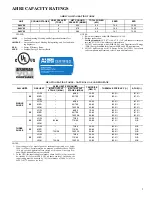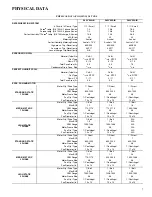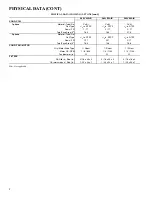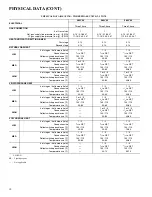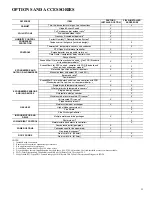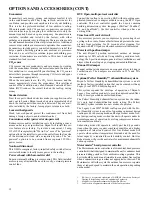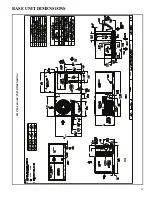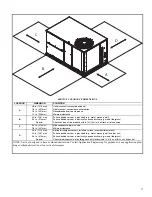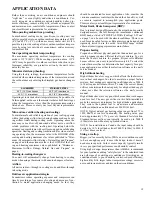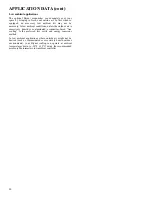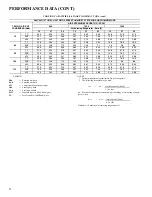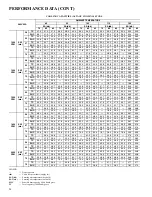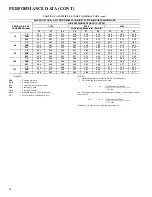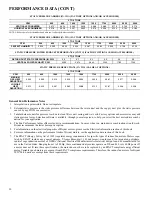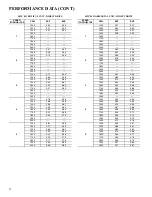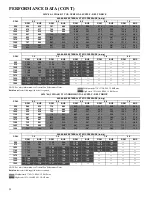
19
Rather than oversizing an air conditioner, engineers should
“right size” or even slightly undersize air conditioners. Cor-
rectly sizing an air conditioner controls humidity better, pro-
motes efficiency, reduces utility bills, extends equipment life,
and maintains even, comfortable temperatures. Please contact
your local Bryant representative for assistance.
Min operating ambient temp (cooling)
In mechanical cooling mode, your Bryant rooftop unit can
safely operate down to an outdoor ambient temperature of 40°F
(4°C) and 25°F (–4°C), with an accessory winter start kit. It is
possible to provide cooling at lower outdoor ambient tempera-
tures by using less outside air, economizers, and/or accessory
low ambient kits.
Max operating ambient temp (cooling)
The maximum operating ambient temperature for cooling
mode is 115°F (46°C). While cooling operation above 115°F
(46°C) may be possible, it could cause either a reduction in per-
formance, reliability, or a protective action by the unit’s inter-
nal safety devices.
Min mixed air temp (heating)
Using the factory settings, the minimum temperatures for the
mixed air (the combined temperature of the warm return air and
the cold outdoor air) entering the dimpled, gas heat exchangers
are:
Operating at lower mixed-air temperatures may be possible, if a
field-supplied, outdoor air thermostat initiates both heat stages
when the temperature is less than the minimum temperatures
listed above. Please contact your local Bryant representative
for assistance.
Min and max airflow (heating and cooling)
To maintain safe and reliable operation of your rooftop, operate
within the heating airflow limits during heating mode and cool-
ing airflow limits during cooling mode. Operating above the
max may cause blow-off, undesired airflow noise, or airflow
related problems with the rooftop unit. Operating below the
min may cause problems with coil freeze-up and unsafe heating
operation. Heating and cooling limitations differ when evaluat-
ing operating cfm, the minimum value is the HIGHER of the
cooling and heating minimum cfm values published in “Mini-
mum - Maximum Airflow Ratings–Natural Gas and Propane”
on page 6 and the maximum value is the LOWER of the cool-
ing and heating maximum values published in “Minimum -
Maximum Airflow Ratings–Natural Gas and Propane” on
Heating-to-cooling changeover
Your unit will automatically change from heating to cooling
mode when using a thermostat with an auto-changeover feature.
Airflow
All units are draw-through in cooling mode and blow-through
in heating mode.
Outdoor air application strategies
Economizers reduce operating expenses and compressor run
time by providing a free source of cooling and a means of ven-
tilation to match application changing needs. In fact, they
should be considered for most applications. Also, consider the
various economizer control methods and their benefits, as well
as sensors required to accomplish your application goals.
Please contact your local Bryant representative for assistance.
Motor limits, Brake horsepower (BHP):
Due to internal design of Bryant units, the air path, and specially
designed motors, the full horsepower (maximum continuous
BHP) band, as listed in “PHYSICAL DATA (Cooling) 3-5 Tons”
on page 7, can be used with the utmost confidence. There is no
need for extra safety factors, as Bryant motors are designed and
rigorously tested to use the entire, listed BHP range without
either nuisance tripping or premature motor failure.
Propane heating
Propane has different physical qualities than natural gas. As a
result, propane requires different fuel to air mixture. To opti-
mize the fuel/air mixture for propane, Bryant sells different
burner orifices in an easy to install accessory kit. To select the
correct burner orifices or determine the heat capacity for a pro-
pane application, use either the selection software or the unit’s
service manual.
High altitude heating
High altitudes have less oxygen, which affects the fuel/air mix-
ture in heat exchangers. In order to maintain a proper fuel/air
mixture, heat exchangers operating in altitudes above 2000 ft
(610 m) require different orifices. To select the correct burner
orifices or determine the heat capacity for a high altitude appli-
cation, use either the selection software or the unit’s service
manual.
High altitudes have less oxygen, which means heat exchangers
need less fuel. The new gas orifices in this field-installed kit
make the necessary adjustment for high altitude applications.
They restore the optimal fuel to air mixture and maintain
healthy combustion on altitudes above 2000 ft (610 m).
NOTE: Typical natural gas heating value ranges from 975 to
1050 Btu/ft
3
at sea level nationally. The heating value goes
down approximately 1.7% per every thousand feet elevation.
Standard factory orifices can typically be used up to 2000 ft
(610m) elevation without any operational issues.
NOTE: For installations in Canada, the input rating should be
derated by 10% for altitudes from 2000 ft (610m) to 4500 ft
(1372m) above sea level.
Sizing a rooftop
Bigger isn’t necessarily better. While an air conditioner needs
to have enough capacity to meet the design loads, it doesn’t
need excess capacity. In fact, excess capacity typically results
in very poor part load performance and humidity control.
Using higher design temperatures than ASHRAE recommends
for your location or adding “safety factors” to the calculated load
are both signs of oversizing air conditioners. Oversizing an air
conditioner leads to poor humidity control, reduced efficiency,
higher utility bills, larger indoor temperature swings, excessive
noise, and increased wear and tear on the air conditioner.
ALUMINIZED
STAINLESS STEEL
50°F (10°C) continuous
40°F (4°C) continuous
45°F (7°C) intermittent
35°F (2°C) intermittent
APPLICATION DATA

